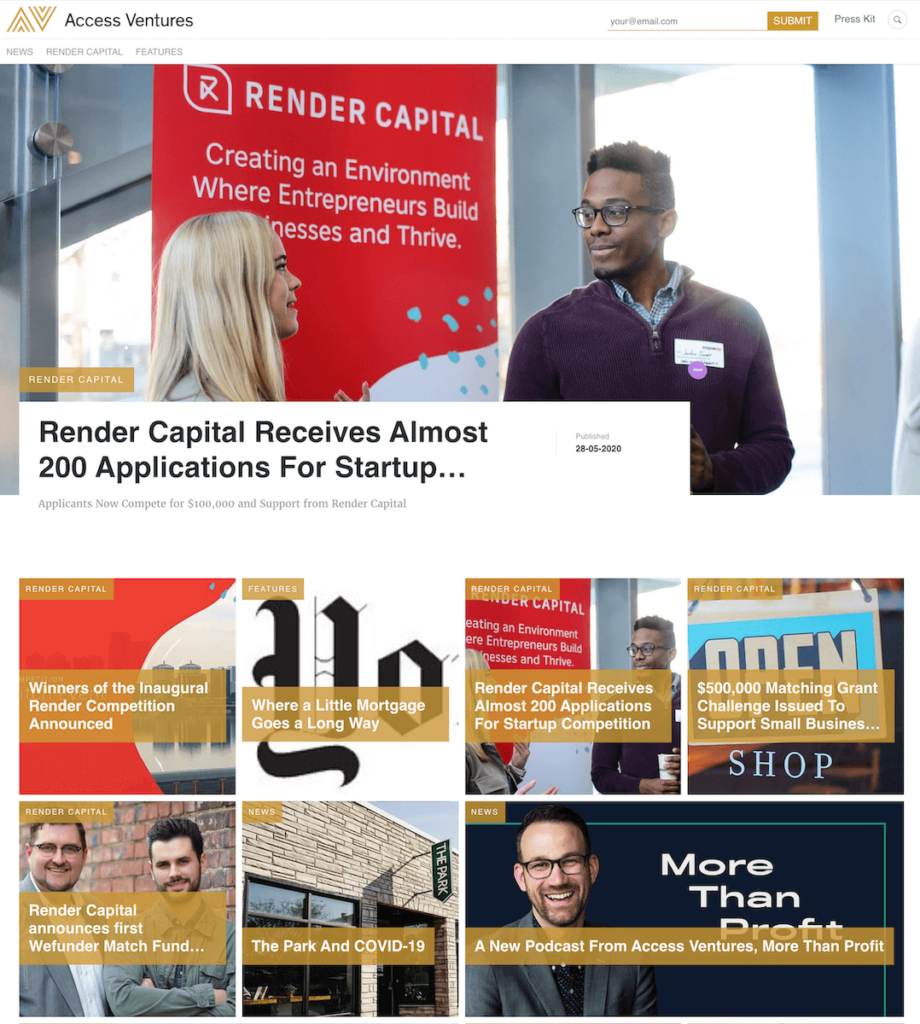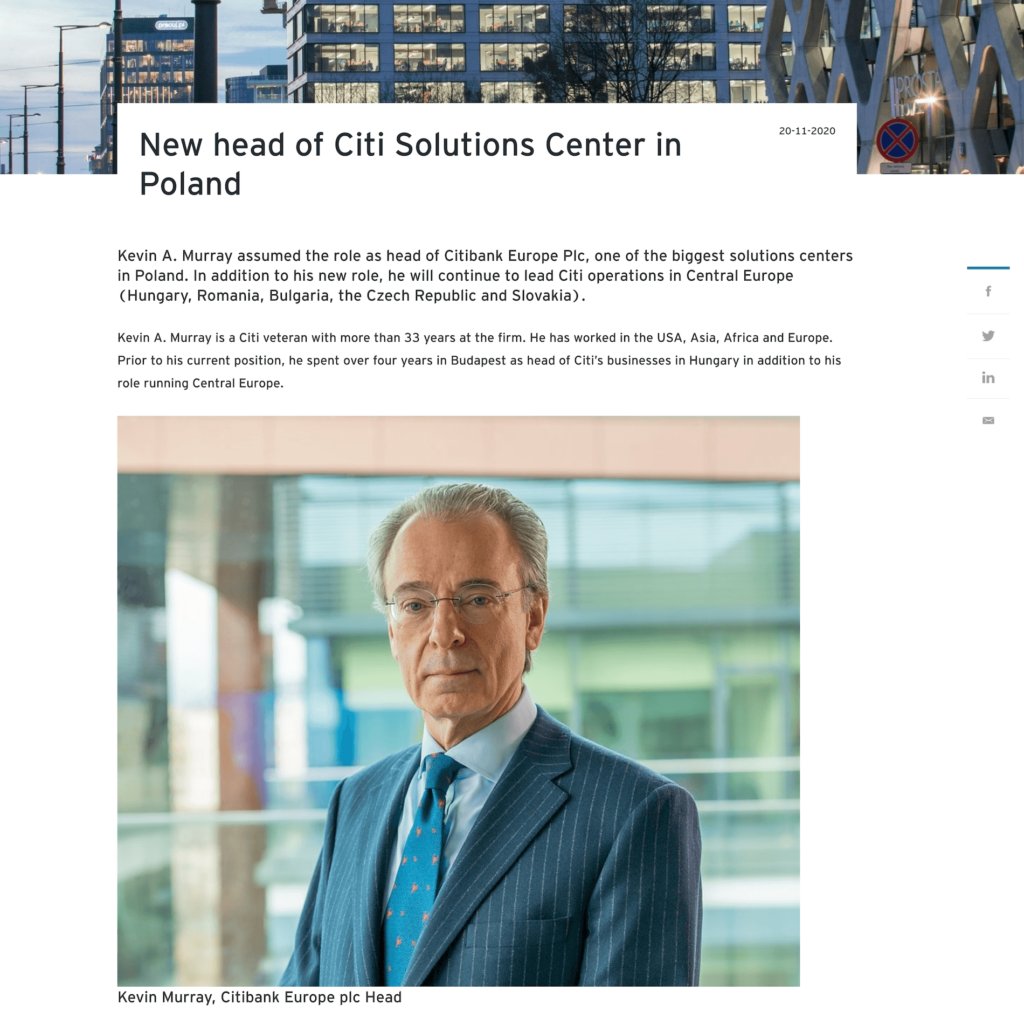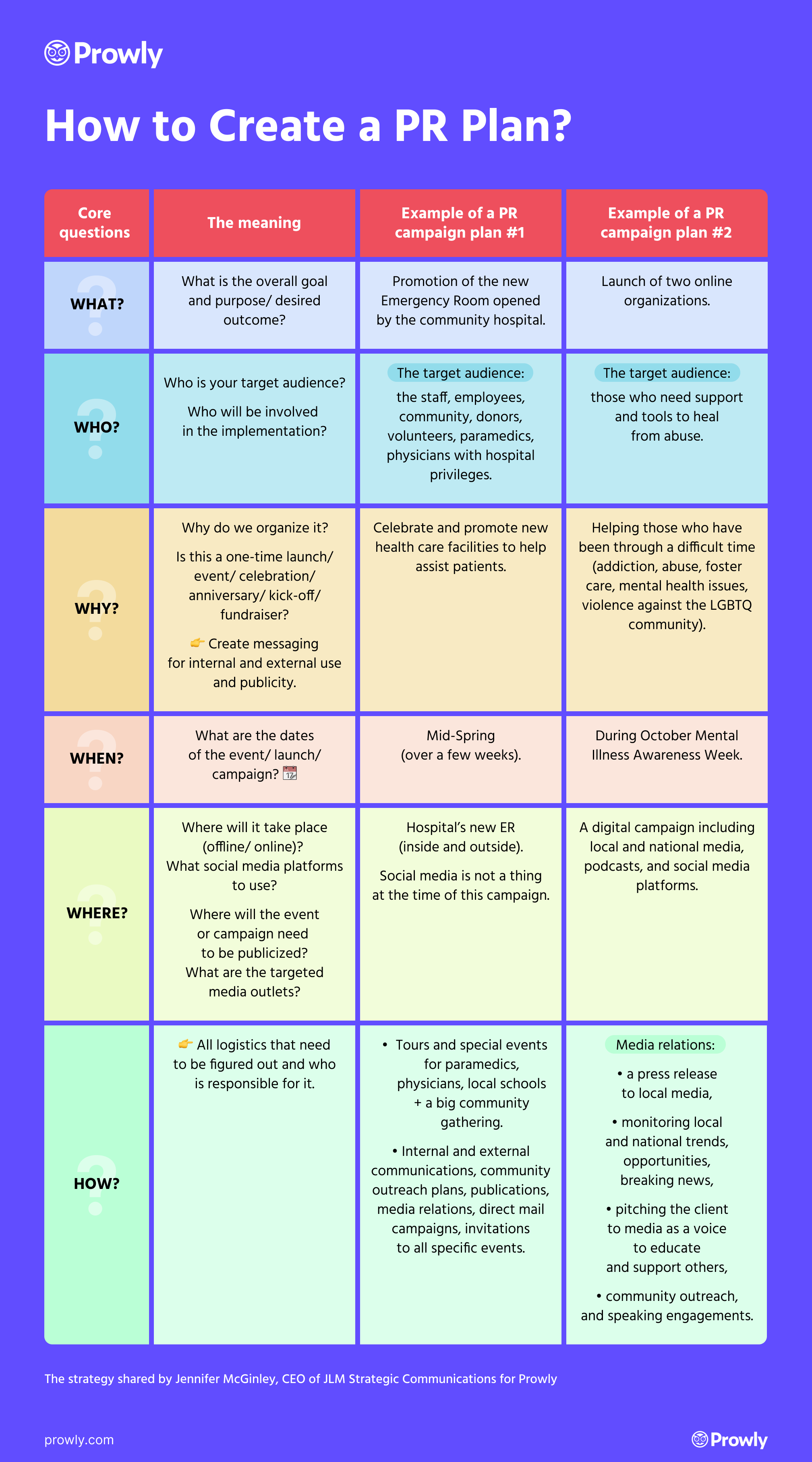Public relations is all about influencing attitudes and behaviors. To be able to do this effectively, though, companies need a solid digital PR strategy, designed to work towards pre-defined goals and objectives.
Luckily, there are several common steps to all PR plans listed by PR experts. By following them, you can create a PR strategy for just about any organization:
- Outline PR goals
- Do your research
- Get to know your target audiences
- Set the objectives (and PR plan timeline)
- Choose PR tactics
- Measure results
- Leverage simple PR plan template
Without further ado, here’s your step-by-step guide to creating a PR plan.
How to create a PR strategy
Strategic PR planning takes work. Even more important, it first takes thinking and preparation. Follow the PR strategy outline below to get started.
Outline PR goals
Outlining your PR goals is a good place to start creating a PR plan. According to Gregg Feistman, Assistant Chair for Public Relations @ Temple University, you should think of the ultimate thing you want to accomplish with your PR efforts, be it:
- Creating an entrée for increased sales
- Improving employee productivity and morale
- Increasing recruitment and retention
- Improving relationships with the communities your company does business with
- Finding allies as an inoculation against future possible crises
- Launching a product or service
- Entering a new geographic market
- Closing the perception gap
Once it’s clear what your PR goals are, it’s time to take a step further.
Do your research
To create a solid PR strategy, you might want to do your research and develop an in-depth understanding of the brand you represent. This also includes relevant trends, media narrative, and audience sentiments.
Erin Yamauchi, Director of Public Relations @ eStreet.co, usually starts with a simple SWOT analysis and listing:
- STRENGTHS – things the brand does well, distinctive brand attributes that set it apart from others, resources available to support brand growth, leading products/services
- WEAKNESSES – areas of improvement for the brand, things competitors do better, superior products/services, clarity needed surrounding distinctive brand attributes, muddled messaging
- OPPORTUNITIES – underserved markets, untapped audiences, emerging markets, or new needs for brand’s products/services
- THREATS – emerging competitors, downward trends/need for products/services, industry conflicts, negative audience sentiment
At this stage, it’s also important to take a closer look at how your brand communicates through different channels and platforms (including your own website, social media profiles, and online newsroom). Gregg Feistman’s advice is to ask yourself the following questions:
- What’s your website like? Is it easy to find, easy to read, easy to navigate? Are the colors, layout, and design legible? Is there anything you think is really important that’s missing? The same goes for your online newsroom
- What’s your social media presence like? Do you have one? If so, how much engagement does it get?
- Were you in the media recently? Was the media coverage positive, negative, or neutral in tone?
- What about the messages in your newsletters, mailings, signs, fliers? Are they the things your audience is interested in? For example, studies have shown employees prioritize what’s going on in the firm much higher than things like anniversaries, birth announcements, and service celebrations
What you’re doing is known as a communication audit – a 360-degree view of what and how you communicate to all the audience important to you.

Example of an online newsroom created in Prowly by Access Ventures
Get to know your target audiences
According to Erin Yamauchi, PR practitioners should know a brand’s key audiences inside and out. Basic demographic information (e.g. age, gender, geographic region, HHI) is a good foundation, but understanding more qualitative attributes (e.g. interests, priorities, lifestyle aspirations) is key to creating a PR plan.
What definitely helps with strategic PR planning, is also knowing how your target audiences perceive your business. You can ask people directly about their perceptions, and use different media monitoring & data analytics tools to find these out.
Think of a PR strategy as a positioning statement: “Position YOUR ORGANIZATION as X.” How do you fill in the blank? You don’t have to. If you’ve done the right research and you’ve asked the right questions, your audience will do it for you. They’ll tell you what characteristics they associate with you.
If it’s not what you want to be associated with, that’s called a communication or perception gap, between what you want audiences to think of you as vs. how they currently perceive you. Then, we use communication techniques to close that gap. – Gregg Feistman, Assistant Chair for Public Relations @ Temple University
But, knowing target audiences and their perception of you is only half the battle. Erin Yamauchi adds that it’s essential to know which outlets target audiences frequent, where they get their news, which media voices they trust. There should also be an understanding of nontraditional platforms – aggregate publications, social networks, podcasts, blogs, discussion forums, and consumer review sites, just to name a few.
Once you have the data and can detect different patterns and trends, you can start setting the objectives.
Set the objectives (and PR plan timeline)
As stated by Gregg Feistman, objectives should be created for each target audience that’s important to the organization. They can overlap or be completely separate, depending on your PR goals.
Nonetheless, objectives must contain two things: a quantifiable result and a PR plan timeline. They’re usually one sentence long, i.e. Increase X by Y% in six months. This way you’ll be able to measure your final results against your efforts and what you accomplished.
A common model of objectives are what’s called SMART objectives:
- Specific – for example, “improving awareness” is too broad
- Measurable – objectives without a measurable aren’t objectives
- Attainable – is it something you have the resources to attain? Is it realistic? Stretch, sure. But make sure you’re not asking for the impossible. And remember, awareness and change in opinion must occur before changes in behavior. The best way to ensure you get what you want is when there are low cost and a high reward to the people you’re communicating with
- Relevant – are the changes you seek relevant to the target audiences (not to you)? “Don’t text and drive” is relevant to the person behind the wheel first, the other drivers and pedestrians second. There are consequences to all three, but the driver will suffer the most if caught
- Time-Bound – short-term objectives generally focus on knowledge and awareness. Long-term objectives can more successfully drive changes in attitudes and behaviors
Speaking of PR plan timeline, Jennifer McGinley, CEO @ JLM Strategic Communications tends to get out a calendar to map out important dates and works backward to organize everyone’s responsibilities and deadlines. After all, a strategic PR plan is only as good as those who implement it and work well together.
Now, for the fun part.
Choose PR tactics
This is the fun stuff: think press releases, social media posts, events – there are plenty of PR tactics to choose from. However, if they don’t support the positioning you want to achieve and how you want to be portrayed, then either change them or don’t devote the resources towards them.
Gone are the days where publicists focused on serving clients through telephone-based relationships or expensive dinners. No longer is print, TV, and radio the only avenues through which an organization can speak to the public. As public relations changes, so too do the tactics and goals of a successful strategy. With a world of new mediums and platforms now only a mouse-click away, new forms of digital PR tactics are emerging every day. – Emerald Jane-Hunter, Founder @ myWHY Agency
Here, we look at some of the tried-and-tested types of PR tactics that work:
Press releases. While press releases were traditionally reserved for big company announcements, they have become bread and butter communication tools in the digital realm. There are plenty of press release tips and templates available online to get started with, in case you don’t have a lot of experience with press release writing.

Press Release example from Citibank created in Prowly
Online articles & guest posts. Well-researched, thought-provoking online articles have the capacity to offer an insightful look into how your organization wishes to present itself to the world. Besides the potential for using these publications to establish a company as a thought leader, they are also valuable resources for generating backlinks and driving valuable traffic to your website.
Influencer marketing. We’ve all seen how influencers are directing public opinion on what to buy and where to buy it. Including influencer marketing in your PR plan will add a potent weapon to your arsenal. Influencers often have tens of thousands of followers who rely upon their opinions to make purchase decisions.
Media outreach. PR pros need to understand how and who to pitch. It’s also crucial to stay in touch with key media, nurturing relationships, and staying mindful of journalists’ own deadlines, life events, and anything else that may impact how they receive a pitch.
Corporate videos and interviews. People love to take a peek at what a company is all about. Corporate videos and showcasing facilities and people can go a long way in giving a ‘face’ to your organization. The same goes for interviews. When your audience has the opportunity to actually hear from your team, they tend to pay more attention to your message. The digital realm has opened up a whole new world in which these videos and interviews are easily accessible.
How to make sure you choose the right PR tactics for your PR strategy, though? Jo Detavernier, Principal @ Detavernier Strategic Communication recommends applying a “lean PR” approach:
When choosing PR tactics to employ, you will depart from a hypothesis of what will work and what will not work to achieve a certain communication objective with a well-defined stakeholder group. This hypothesis will often be based or at least it will be partially influenced by your measurement of past results from similar (enough) campaigns.
But, even when there are plenty of arguments to believe that a certain PR tactic will work, you will still test the waters and pivot the execution of your plan as soon as you see a need to do so. One way to go about the testing is to work with “pilots” where, for example, when you pitch journalists, you do not allow yourself to arrive in a situation where you have finished an entire round of pitching using one single story angle to then have to report back that the media did not “bite.” No, a story is pitched to a few journalists, and lessons are learned with the first few media pitches.
Where changes need to be made on what the story looks like and how it is told, these changes will have to be made before you start to scale. This is just one example, but the approach is applicable if you care to apply a “lean PR” approach, to all stakeholder outreach where testing is an option.
Measure results
Alright, here’s why your objectives have to be measurable in the first place – you’re now going to measure and evaluate if what you did achieve was what you were going for in your PR plan.
Despite some lingering assumptions that PR cannot be measured, there are a host of ways to demonstrate to stakeholders that PR efforts have an impact. Erin Yamauchi, Director of Public Relations @ eStreet.co, usually aims for the following ways to measure the results:
- Metrics – tracking engagement, website traffic, and audience reach including social media shares helps to understand how far your messages go
- Brand sentiment – highlighting key message mentions, quotes, and other story inclusions that support brand affinity and positive sentiment
- Competitive analysis – another great measure (provided the resources are available) is to look at where your direct competitors are being featured and ensure your brand has equal (and then some) placements
Depending on your PR goals, digital tools, and data available, you might want to measure your PR results differently. The exact metrics don’t matter, as long as you keep an eye on how your PR plan is being executed and what it means for the company. Stick to the plan, but also be flexible when needed.
Leverage a PR plan template
Looking for a simple (but powerful) PR strategy template to get you started? Here’s what works for Jennifer McGinley, CEO @ JLM Strategic Communications:
As a PR practitioner for over 25 years in healthcare and nonprofits, I have found that answering the WHO, WHAT, WHERE, WHEN, WHY, and HOW are the best way to get started on a PR strategy:
WHO: Who is your target audience, who will be involved in the implementation
WHY: What is the overall goal and purpose, desired outcome
WHAT: Is this a one-time launch, event, celebration, anniversary, kick-off, fundraiser. Create messaging for internal and external use, and publicity
WHERE: Where will it take place? Offline or online? What social media platforms? Live location? Is this an event or a launch? Where will the event or campaign need to be publicized? What are the targeted media outlets?
WHEN: What are the dates of the event, launch, campaign, etc.
HOW: All logistics that need to be figured out and who is responsible for it
When this PR strategy template is filled in, organized, dates added to calendar and charts, and those responsible for all tasks, the plan will take shape and make sense. Take a look at the examples of PR campaign plans below.
PR plan examples

Ready to give your PR strategy a thought? With Prowly, you can actually save time on executing PR plans – from finding relevant media contacts to creating visual press releases, sending email pitches, and maintaining journalist-friendly newsrooms.
Cover photo by Jani Kaasinen


